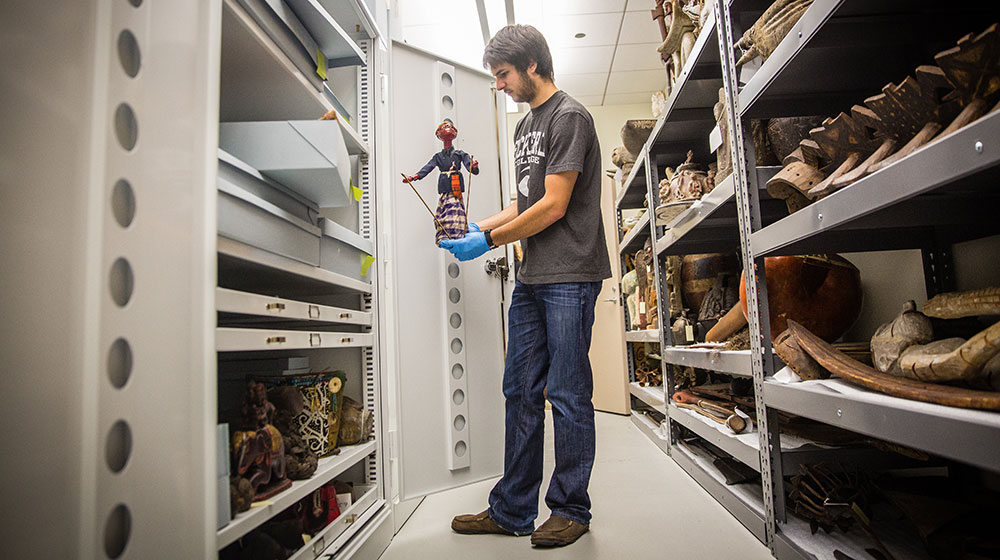Bringing art to life

Christian Franck, a student in the Department of Anthropology’s museum studies internship course, holds a puppet that will be in LUMA’s upcoming exhibition on Indonesian puppetry. (Photo: Natalie Battaglia)
By Anna Gaynor
Starting this February, the Loyola University Museum of Art and the Department of Anthropology will make you rethink puppetry.
What: “Wayang: The Art of Indonesian Puppetry”
When: February 4–June 3, 2017
Where: Loyola University Museum of Art; 820 N. Michigan Avenue, Chicago
• Learn more at the LUMA website.
While many people think of children’s TV shows when they hear the word “puppet,” in reality, the Indonesian pieces on display at LUMA are part of a regional, historical, and artistic tradition dating back to the 10th century.
“It’s fun because this isn’t something, at least from my experience, most people really know about,” said Liz Bajjalieh, an anthropology major. “I’m taking this little shadow puppet from a little corner of the world, so an entire other world of people can experience it.”
In addition to shadows puppets, known as wayang kulit, the new LUMA exhibit will showcase wayang golek, hand-carved wooden puppets. Students have taken on every aspect of putting together the exhibit—from researching the pieces, writing display text, and designing displays.
“Part of me is excited because this is the first time that a project I’ve done in an academic space isn’t just within the confines of the classroom,” Bajjalieh said. “This is applied. This is somewhere where Loyola students and LUMA’s neighbors will actually see my work. I get to educate people.”
The collection
LUMA’s curator, Natasha Ritsma, first approached Catherine Nichols, a lecturer in the Department of Anthropology, about having students create and develop an exhibit featuring pieces from Loyola’s May Weber Ethnographic Study Collection.
“This has been a wonderful opportunity for a nice partnership between our department, this collection, and LUMA,” said Nichols, the instructor of the course Internship in Anthropology: Museum Studies. “Prior to May’s passing, she had actually shown parts of this collection at LUMA before. I think it’s exciting to have some of these objects that have been shown in museums before—but now they’re being curated by our students.”
The big challenge is what Nichols calls “contextualizing” each piece. That means understanding the character as well as its role in Indonesian culture and storytelling. Teaching lessons about history and morality, these performances are a normal part of social life in Java, the island where these puppets came from.
The puppets represent a small part of the entire Weber collection, which includes pieces from Asia, Africa, Oceania, and Latin America. Gerry Hoffman, Weber’s husband, said his wife was a psychiatrist and was always interested in how the human mind worked—but she also found art and beauty in ordinary things.
“One of her deep beliefs is that people ought to be surrounded by beautiful things and sometimes that beauty could be found in the most unlikely things,” he said. “Like a spoon, the most prosaic object you can imagine, might have a handle that is the most glorious piece of sculpture that is totally irrelevant to its use as a spoon but in her mind it was relevant. It was something nice to look at.”
Interactive art
Hoffman said though they were in the process of finding a permanent home for the 2,500-piece collection when Weber passed away in 2012, she would appreciate the way Loyola students are invited to interact with the collection.
“Merely looking at a piece is insufficient. You ought to handle a piece,” Hoffman said. “The fact that a lot of these pieces ended up in the hands of students would be very pleasing to her.”
Meg Ruddy, an art history major who wanted to learn more about art conservation, also hasn’t missed the beauty in the wayang pieces. Her hope is that she can make them more relatable to museum visitors.
“It’s very cool how much effort went into detail and color—the color especially,” Ruddy said. “When they’re in use, you’re not going to see the color. You see the shadow that it gives. I love seeing that so much time and care went into the construction of something that viewers may not even ever see. I think that shows a real passion of the artist, which I appreciate.”
